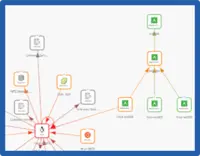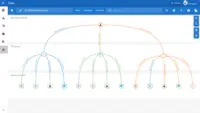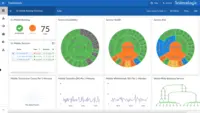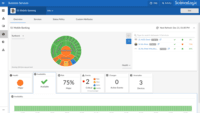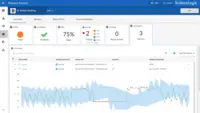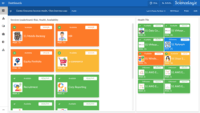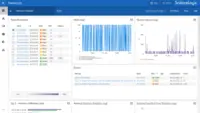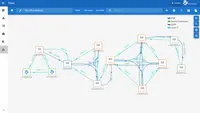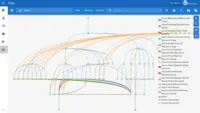Overview
What is ScienceLogic SL1?
ScienceLogic is a system and application monitoring and performance management platform. ScienceLogic collects and aggregates data across and IT ecosystems and contextualizes it for actionable insights with the SL1 product offering.
Propel your digital transformation.
SL1 in a Managed IT Services Environment
Monitoring Suite that lags way behind for Modern Use Cases
Apart from …
Sl1 Review
Feedback on ScienceLogic
***Wonders of SL1***
One-Stop Solution - ScienceLogic SL1
SL1 has been stronger partner to work with
ScienceLogic SL1 in my views
Insights of ScienceLogic monitoring tool
Science Logic : Journey from Better to Best
ScienceLogic SL1 Top Notch Monitoring Platform
How ScienceLogic SL1 Differs From Its Competitors
Impact on Infrastructure Visibility
Using ScienceLogic to Support New Business
Using ScienceLogic to Support New Business
ScienceLogic Integration
Impact on Infrastructure Visibility
Using ScienceLogic to Support New Business
ScienceLogic Integration
Impact on Infrastructure Visibility
Using ScienceLogic to Support New Business
ScienceLogic Integration
Impact on Infrastructure Visibility
I recommend to buy this platform. Also some development skills will need if some features are not comming in the standard product, this will also imply …
Using ScienceLogic to Support New Business
In most of the cases works quite good. Nowadays, for new …
Impact on Infrastructure Visibility
Using ScienceLogic to Support New Business
ScienceLogic Integration
Impact on Infrastructure Visibility
Using ScienceLogic to Support New Business
ScienceLogic Integration
ScienceLogic Integration
Using ScienceLogic to Support New Business
ScienceLogic Integration
Impact on Infrastructure Visibility
Using ScienceLogic to Support New Business
ScienceLogic Integration
Impact on Infrastructure Visibility
Using ScienceLogic to Support New Business
ScienceLogic Integration
Using ScienceLogic to Support New Business
ScienceLogic Integration
Impact on Infrastructure Visibility
Using ScienceLogic to Support New Business
ScienceLogic Integration
Impact on Infrastructure Visibility
Using ScienceLogic to Support New Business
ScienceLogic Integration
Impact on Infrastructure Visibility
Using ScienceLogic to Support New Business
ScienceLogic Integration
Impact on Infrastructure Visibility
Using ScienceLogic to Support New Business
ScienceLogic Integration
ScienceLogic Integration
Impact on Infrastructure Visibility
This has improved as SL1 offers deeper levels of monitoring and also easier management of the platform (Ease of management is important as changes are more likely to get done. If I make an improvement to a …
Using ScienceLogic to Support New Business
ScienceLogic Integration
Impact on Infrastructure Visibility
When moving to ScienceLogic we gained a deeper insight into our infrastructure, its functionality and health alongside providing us with a more in-depth dashboarding tool-set.
We are also hoping with the move to service orientated dashboarding this will provide us with better visibility of …
Using ScienceLogic to Support New Business
ScienceLogic Integration
Previously we used ScienceLogic to be a trigger point on our automated self-healing pipeline, but we have recently started testing the out of the box features within SL1 to automate system recovery.
It plugs in well/integrates well with other tooling we use which is assisting us to remove the …
Impact on Infrastructure Visibility
Using ScienceLogic to Support New Business
ScienceLogic Integration
Impact on Infrastructure Visibility
Using ScienceLogic to Support New Business
ScienceLogic Integration
Impact on Infrastructure Visibility
Using ScienceLogic to Support New Business
ScienceLogic Integration
Impact on Infrastructure Visibility
Using ScienceLogic to Support New Business
ScienceLogic Integration
Impact on Infrastructure Visibility
Using ScienceLogic to Support New Business
ScienceLogic Integration
Impact on Infrastructure Visibility
Using ScienceLogic to Support New Business
ScienceLogic Integration
These are the benefits we noticed for automating our monitoring through ScienceLogic:
- Improved security and compliance. Automatically record and audit all employee actions within a workflow, safeguard vital data, restrict access and roles of users and alert project owners when any problems arise.
- Cen…
Awards
Products that are considered exceptional by their customers based on a variety of criteria win TrustRadius awards. Learn more about the types of TrustRadius awards to make the best purchase decision. More about TrustRadius Awards
Reviewer Pros & Cons
Video Reviews
1 video
Pricing
Entry-level set up fee?
- Setup fee required
Offerings
- Free Trial
- Free/Freemium Version
- Premium Consulting/Integration Services
Starting price (does not include set up fee)
- $7.50 per month per node
Product Details
- About
- Integrations
- Competitors
- Tech Details
- Downloadables
- FAQs
What is ScienceLogic SL1?
The ScienceLogic SL1 platform aims to enable companies to digitally transform themselves by removing the difficulty of managing complex, distributed IT services. SL1 uses patented discovery techniques to find everything in a network, so users get visibility across all technologies and vendors running anywhere in data centers or clouds. The vendor states the advantage of SL1 is that it collects and analyzes millions of data points across an IT universe (made up of infrastructure, network, applications, and business services), to help users make sense of it all, share data, and automate IT processes.
With SL1, the user can:
- See everything across cloud and distributed architectures. Discover all IT components—–across physical, virtual, and cloud. Collect, merge, and store a variety of data in a clean, normalized data lake.
- Contextualize data through relationship mapping and machine learning (ML) for actionable insights. Use this context to understand the impact of infrastructure and applications on business service health and risk, accelerate root cause analysis, and execute recommended actions.
- Act on data that is shared across technologies and IT ecosystem in real time. Apply multi-directional integrations to automate workflows at cloud scale.
ScienceLogic SL1 Features
- Supported: Infrastructure Monitoring (Cloud, Container, Server, Storage, Agent-Based, Network, Application, Database, UC/Video, Synthetic)
- Supported: Closed-Loop Automations (Digital Experience Monitoring, CMDB & Inventory, Incident & Notifications, NetFlow, Configuration and Change Management, Troubleshooting & Remediation
- Supported: Topology-Driven Event Correlation
- Supported: Full-Stack Topology Mapping
- Supported: Business Service Monitoring
- Supported: Behavioral Correlation (Events, Changes, Anomalies, Topology)
- Supported: Analytics - ML-Based Anomaly Detection
- Supported: Incident Automation - Event Forwarding & Email
- Supported: Dynamic Baselining Analytics
- Supported: Manage Workflow Health & Endpoints
- Supported: Dashboards and Reporting
- Supported: Log Collection
- Supported: 400+ Pre-Built Monitoring Integrations
ScienceLogic SL1 Screenshots
ScienceLogic SL1 Videos
Watch Eliminating Visibility Gaps While Driving Tool Consolidation
Watch Diagnosing and Resolving Service Impacting Issues with Behavioral Correlation
Watch Automating Troubleshooting for Faster Root Cause Analysis
Watch CMDB Accuracy With Real-time Synchronization of Monitored Environment
Watch Understanding Infrastructure Impact on Apps with AppDynamics
ScienceLogic SL1 Integrations
- Kubernetes
- Cisco HyperFlex
- Nimble
- Hyper-V
- MySQL
- Dynatrace
- New Relic
- Cloud -AWS
- Azure
- Google Cloud
- IBM Cloud
- Aliyun
- CloudStack
- OpenStack
- etc.
- Cloud Services – Amazon EKS
- ECS
- Fargate; Azure AKS; etc.
- Containers – Docker
- etc.
- Software-defined Networks/WAN – Cisco
- VMware
- etc.
- Network - Cisco
- F5
- Juniper
- Meraki
- Riverbed
- Aruba
- Avaya
- Fortinet
- HP
- etc.
- Storage - Dell EMC
- NetApp
- HPE
- Hitachi
- Nutanix
- Pure Storage
- etc.
- Hypervisors – VMware
- Xen
- KVM
- etc.
- Operating Systems - Unix
- Windows
- Linux
- Business Applications
- Databases - Microsoft
- SAP
- Office 365
- MS SQL Server
- Oracle
- IBM DB2
- etc.
- APM - AppDynamics
- etc.
- etc.
- Storage - Dell EMC
- NetApp
- Pure
- HP/Nimble
- etc.
- Cloud -AWS
- Azure
- IBM
- Aliyun
- Openstack
- etc.
- Applications -Microsoft
- SAP
- etc.
- Compute -VMWare
- Microsoft Hyper-V
- KVM
- Linux
- Unix
- Converged -Nutanix
- Unified Communications and video - Cisco
- Polycom
- Tandberg
ScienceLogic SL1 Competitors
ScienceLogic SL1 Technical Details
| Deployment Types | On-premise, Software as a Service (SaaS), Cloud, or Web-Based |
|---|---|
| Operating Systems | Windows, Linux, Mac, UNIX |
| Mobile Application | No |
| Supported Countries | Americas, EMEA, APAC |
| Supported Languages | English |
ScienceLogic SL1 Downloadables
Frequently Asked Questions
ScienceLogic SL1 Customer Size Distribution
| Consumers | 0% |
|---|---|
| Small Businesses (1-50 employees) | 0% |
| Mid-Size Companies (51-500 employees) | 0% |
| Enterprises (more than 500 employees) | 100% |
Comparisons
Compare with
Reviews and Ratings
(380)Attribute Ratings
- 9.2Likelihood to Renew19 ratings
- 9.9Availability13 ratings
- 8Performance13 ratings
- 9.4Usability13 ratings
- 6.4Support Rating18 ratings
- 8.6Online Training5 ratings
- 8.3In-Person Training5 ratings
- 8.1Implementation Rating78 ratings
- 10Configurability7 ratings
- 8Product Scalability1 rating
- 7.8Ease of integration14 ratings
- 7.7Vendor pre-sale4 ratings
- 8.5Vendor post-sale5 ratings
- 8.5ScienceLogic Infrastructure Visibility Rating68 ratings
Reviews
(1-3 of 3)Propel your digital transformation.
- SL1 provides monitoring for various databases.
- SL1 can monitor all popular operating systems.
- SL1 uses monitoring agents and agentless monitoring.
- SL1 requires a lot of CPU resources.
- User Interface is not intuitive.
- Documentation is poorly organized.
- Monitoring and Alerting
- 90%9.0
- Performance Analytics
- 20%2.0
- Incident Management
- 80%8.0
- Service Desk Integration
- 90%9.0
- Root Cause Analysis
- 10%1.0
- Capacity Planning Tool
- 60%6.0
- Configuration and Change Management
- 10%1.0
- Automated Remediation
- 70%7.0
- Collaboration and Communication
- 80%8.0
- Threat Intelligence
- 10%1.0
- SL1 allows to support multiple clients in one platform.
- SL1 provides technology to support the shift to a hybrid workforce.
- SL1 allows to transform business with intelligent, data-driven automation.
- Red Hat Ansible
- IBM Tivoli Netcool/Omnibus
- Servicenow
- Single Signon
- API (e.g. SOAP or REST)
- ETL tools
- Infrastructure monitoring
- Application monitoring
- Database monitoring
- Containers monitoring
- AIOPs integration
- Cloud monitoring
- Use Netcool event processing for SL1 alerts
- Resources DB synchronization between SL1 and LDS
- SL1 PP Reporting using Ansible command line
- SL1 device onboard & offboard using Ansible command line
- Online Training
SL1 in a Managed IT Services Environment
- Event Monitoring
- Dashboards and creating custom Dashboards
- Device Discovery
- More freedom to create custom dashboards as on the previous versions we could do much more
- The Performance TAB windows is too small and cannot be resized or maximized when looking at reports for "Overview", "File System" and any of those items.
- There are not enough widgets to create stunning dashboard in AP2
- The reporting feauture is a very untouched area.
- Monitoring and Alerting
- 100%10.0
- Performance Analytics
- 100%10.0
- Incident Management
- 100%10.0
- Service Desk Integration
- 100%10.0
- Root Cause Analysis
- 100%10.0
- Capacity Planning Tool
- 100%10.0
- Configuration and Change Management
- 100%10.0
- Automated Remediation
- 100%10.0
- Collaboration and Communication
- 100%10.0
- Threat Intelligence
- 100%10.0
- Better visibility into different customer infrastructures if you are a Managed IT Services Provider
- Offers a "One Tool One Product Solution" to manage all of our customers infrastructures environments. Trend analyses enables us to collate event trends throughout all the customers and easily identify problems that may arise on other customers environments.
- Reporting on devices and software have become much more faster and takes the guess work out of what is in the environment
- BMC Truesight - Wee feed data into BMC TrueSight for our Capacity Management Team
- We have integrated with our customers VMware environments to all info to report on without the need of having to access the vCenter Servers.
- We have also integrated with our customers Citrix environments
- We also integrated with our customers Azure environments without any issues.
- Amazon Web Services
- Service Now
We are standardizing our systems and Service Now is one of those systems that we will be integrating. ScienceLogic has the ability to feed information into the system, that will make our life's so much easier.
- File import/export
- API (e.g. SOAP or REST)
- Implemented in-house
- Increased CPU utilization on overall VmWare infrastructure
- Interference from customer Antivirus product
- Dashboards to have an over all view of our customers infrastructure health
- Data provided by SL1 to BMC TrueSight for Capacity Management
- Event Monitoring of different customer environments
- Dashboards for specific Technologies like the Exchange team, the Wintel Team, the SQL team
- There are a lot of built in monitoring tools that we have not utilized
- We have also just touched the tip of the iceberg when it comes to building a dashboard and we will be catering to the specific needs of our teams
- Auto restart feature in Sl1 will allow us to get event when those crucial services has not started after server reboots and also minimize the P1's that we have as a result of that.
- We created a dashboard that shows the highest process untilisation to identify what was the major cause of High CPU usage in one of our customers.
- We also created custom dashboards to fullfill each individual teams need to be able to perform their daily tasks.
- Cloud Solutions
- Scalability
- Integration with Other Systems
- Ease of Use
- Online Training
- In-Person Training
- The Device Search Functionality
- The Device Investigator
- The Device Reporting function
- Trying to run a report under the report section. Most of our reports do not work and the interface is quite shocking
SL1 is best for Network monitoring and event management
- monitoring
- ticketing
- Event notification
- more customized monitoring should be provided by SL1
- Monitoring and Alerting
- N/AN/A
- Performance Analytics
- N/AN/A
- Incident Management
- N/AN/A
- Service Desk Integration
- N/AN/A
- Root Cause Analysis
- N/AN/A
- Capacity Planning Tool
- N/AN/A
- Configuration and Change Management
- N/AN/A
- Automated Remediation
- N/AN/A
- Collaboration and Communication
- N/AN/A
- Threat Intelligence
- N/AN/A
- Monitoring the servers

